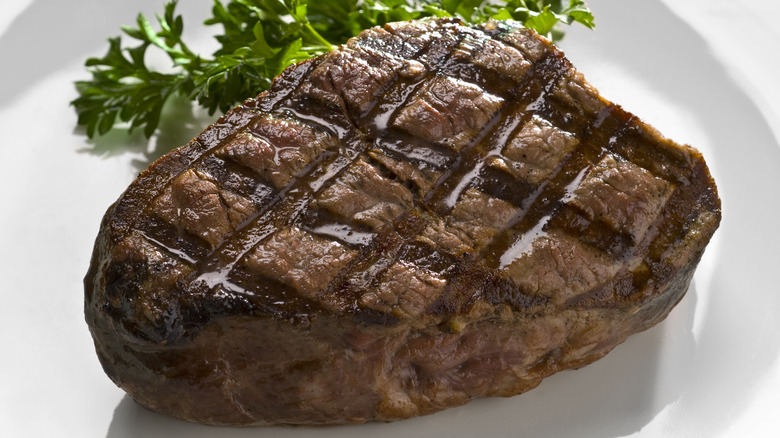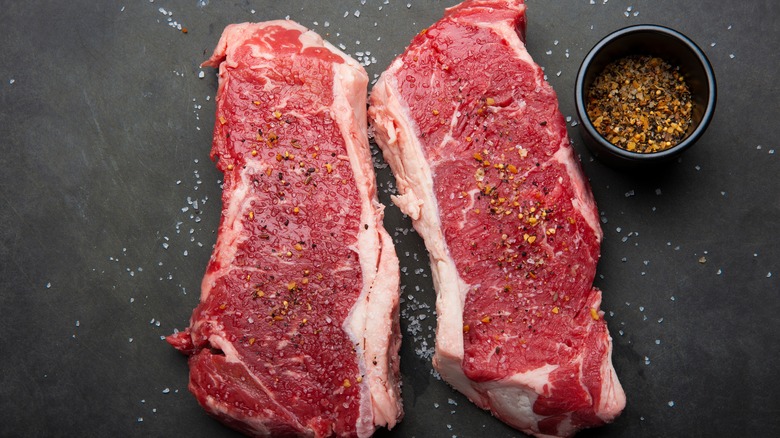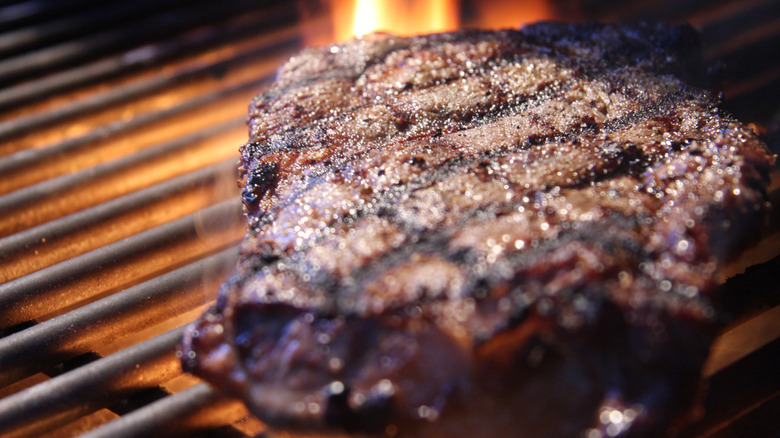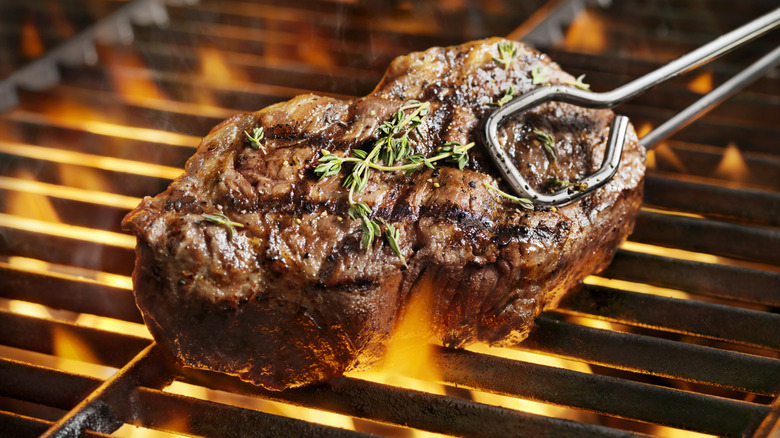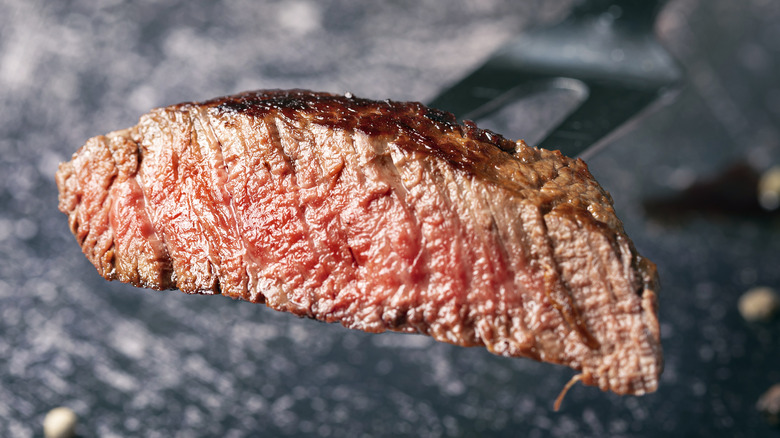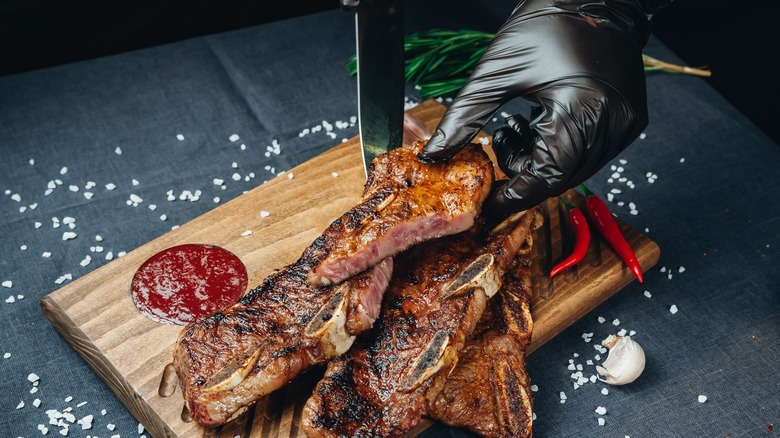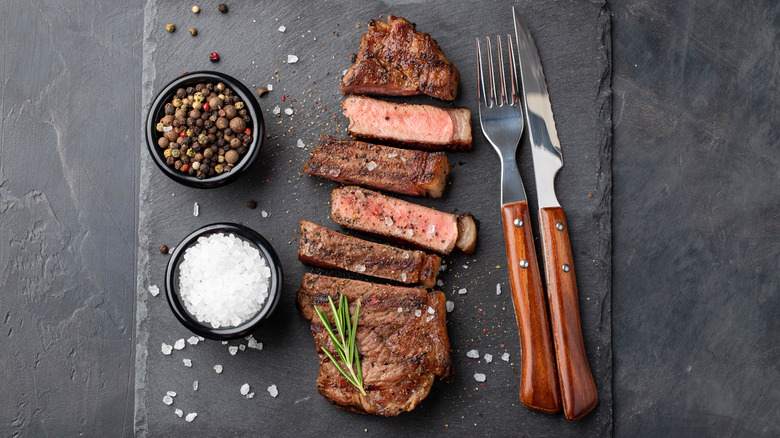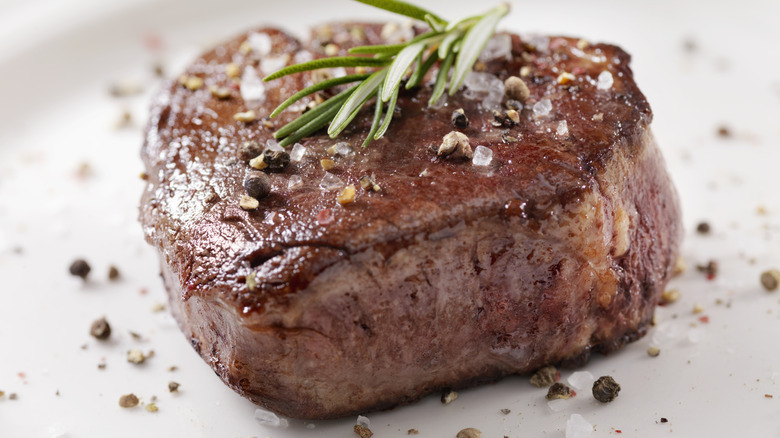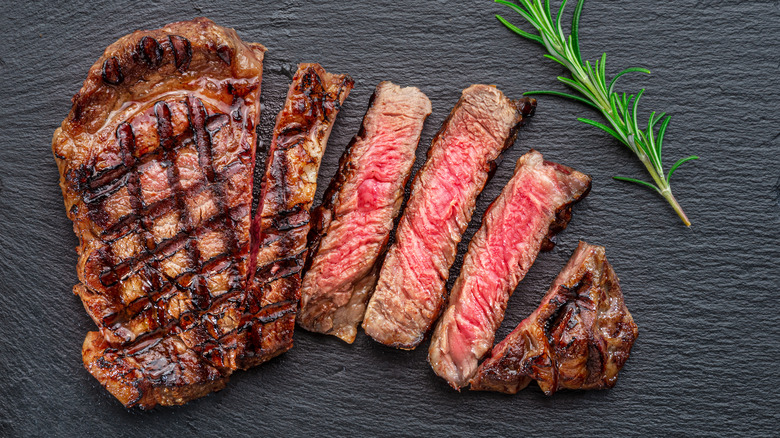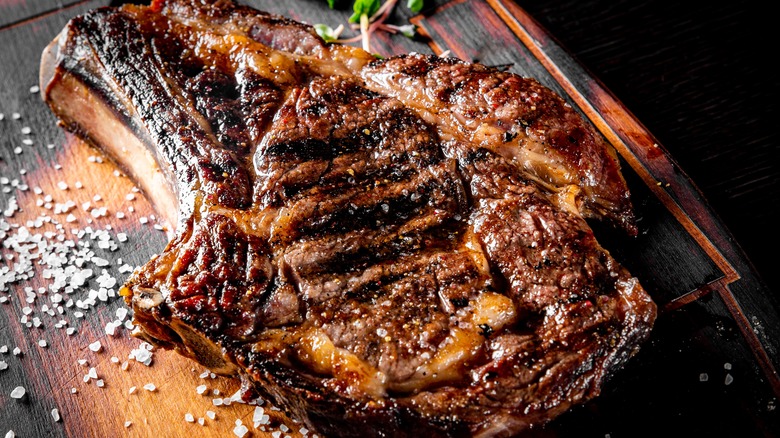Steak Myths You Thought Were True
Myths, legends, mistruths, and misinformation are likely to spread about the most lauded and beloved things, and in the food world, there are few things as well appreciated — and subsequently misrepresented — as steak. Steak looms large in both general culinary and American culture. It's the centerpiece item in what many think of when they think of a nice meal out, either served at a fancy steakhouse on white tablecloths or coming off of a hot grill during a holiday cookout. There are different kinds of steaks favored by so many, but whether it's a ribeye, filet mignon, New York strip, or another, a steak is championed as the absolute epitome of class and good eating.
On the other side of that universal appreciation comes a fear of steak. A cut of high-end beef must be treated correctly, inspiring many myths about this heavily favored protein. Here are some of the most commonly held facts about steak — and why they're almost categorically wrong. To help us sort out what's true and false about steak, we consulted some people who know best: food professionals with extensive experience handling and cooking steak. We talked to two experts: Ashley Lonsdale, chef-in-residence at ButcherBox, and Matthew DiCosimo, sous chef at Tartine Bistro and Wine Bar in Cleveland.
You have to let a steak come to room temperature before cooking it
A steak can be a pricey piece of meat, and one that doesn't need to take many steps to ensure that it makes it to the plate the way it was intended. The first move in steak preparation comes before cooking, and it's a bit of conventional wisdom that one should rest a steak before it goes on the grill. The myth in theory is that taking a steak out of the refrigerator and letting it sit allows the meat, which starts cold, to come up to room temperature. That will make it cook smoother and more evenly, ensuring uniform flavor.
"When I'm setting up to cook, I always pull my proteins out with the rest of my ingredients," chef Ashley Lonsdale admitted to The Takeout. But, she followed this up by mentioning that "if you're going straight from the refrigerator to cooking a steak, it's not a deal breaker."
Kitchen tests, such as one from Cook's Illustrated, prove that leaving a steak on the counter while the grill heats up doesn't do much of anything. The internal temperature of the beef only rises by a few degrees, even if you rest it for an hour or two before cooking. However, you get closer to your meat hitting the danger zone of food safety the longer it sits. Instead, it's more important to ensure you rest your meat after cooking for maximum moisture retention.
Steaks should be cooked on high heat to lock in the juices
The basic way to cook a steak is a two-tiered process. The first step at the start of the cooking process is searing, or placing the raw meat on a grill turned up to a very high heat for few moments or more. At this stage, a chain of chemical changes involving amino acid molecules (the basis of protein, like steak) called the Maillard reaction takes place. The meat becomes embellished with deep, savory flavors in the form of a brown-colored crust. Here in lies the myth: the crust that's developed from the Maillard reaction is believed by many to be so impenetrable that it keeps the juices inside the steak while the steak finishes cooking to temperature over lower or indirect heat. However, moisture and the Maillard reaction are actually inverses of each other. More moisture means less browning.
Only part of this equation is accurate, according to chef Matthew DiCosimo. "Searing does not lock in juices," he said, using well-done steaks as an example. "If you've ever had a well-done steak, it seems dryer." Research supports this as even tests by Serious Eats have proven that sometimes steaks lose more moisture over high-heat searing. The Maillard-created crust doesn't much keep the liquids inside, but searing — such as the 3-3-2-2 method, does have its benefits. "Searing is used to caramelize meat, which enhances the flavor of it."
Don't flip the steak more than once while cooking
Cooking a steak is deceptively simple. You use little more involved than meat and fire. Still, these very few steps must be executed perfectly. Included in that is the familiar notion that flipping your steak while it cooks too many times will ruin it, expelling precious juices that steam the meat. This misconception is based in the thought that constant movement also creates a frequent temperature change for the meat — the off-flame side cools down, and then heats back up, and then cools down again. The myth is that those ups and downs lead to an unevenly cooked and not very tasty steak.
Chef Matthew DiCosimo told The Takeout that although this is a stubborn one, it's a myth all the same. "If you think it's done on one side, and it isn't, just put it back," he said. "You didn't ruin it by touching it." As it turns out flipping doesn't matter as much as you thought. Or rather, it does, but not in the ways you think. Flipping a steak a few times (within reason) leads to more even cooking — and it cooks your meat faster. The longer your steak spends on the heat, the more time it has to lose juice and overcook. Flipping isn't a catastrophic manipulation of temperature, it's just doling out more heat over more surface area, and it can be beneficial overall.
Poking a steak while cooking ruins it
Flipping a steak is vital if one is utilizing a grill — heat is only applied to the side facing the fire, so the cut of beef is going to have to get turned over at some point. There are many different ways to do this — a spatula, tongs, or a long, two-pronged fork included in most any package of grilling tools. However, common knowledge says that the fork shouldn't be used to flip over a steak, or test one to see if it's done, because puncturing the meat makes juices run out. That, in turn, makes a steak dry and essentially ruined.
Actually, using a fork of any kind to flip a steak isn't a big deal at all; its destructive nature has been greatly exaggerated. "You do lose some of the juices if you puncture it with a fork, but not enough for it to matter as long as you're not repeatedly stabbing it," chef Matthew DiCosimo explained to The Takeout. "Puncturing a steak once or twice will not do much harm, but I suggest investing in a pair of tongs to avoid messy flipping," added chef Ashley Lonsdale. America's Test Kitchen ran an experiment in which they cooked two sets of similar steaks to a medium-rare level, flipping one group with tongs and turning the others with a fork. All the steaks lost an equal amount of moisture — 19.6% of their pre-cooking weight.
The finger test is a great way to determine a steak's doneness level
There are ultimately fewer than a half dozen levels of doneness of a cooked steak. When you order a well-done steak you are reaching for the end limit of how far you can char steak within it being edible. Each level of doneness has an internal temperature associated with it, but to avoid using meat thermometers or cutting into the meat, cooks have developed tricks to determine a steak's doneness. One of these is the finger test — touch the steak with a finger and the amount of resistance you get indicates if it's well-done (little push-back) or rare (lots).
While one can develop a sixth sense for grilling steak, the finger test is an imperfect checking method because doneness isn't about feel even the relative pinkness of the inside of the meat, but rather temperature. "Different thicknesses of meat have a different feel for when they are at a certain temperature," chef Matthew DiCosimo said. "It's way easier and practical to just get a meat thermometer."
Specific numbers on a thermometer correlate to a steak's state at the time it's served. Rare steaks should register at 120 to 125 degrees Fahrenheit; medium rare at 130 to 135 degrees Fahrenheit, and well done at 160 to 165 degrees Fahrenheit, for example. Moreover, the finger test doesn't account for variances in steak cuts. Not all ribeyes are cut to the same thickness.
Season only after cooking, because salt dries out the steak
A liberal sprinkling of salt and pepper can be all a steak needs in terms of seasoning. Many cooks and chefs will add salt and pepper to a steak just after grilling and just before serving, while others may make the somewhat controversial choice to salt the meat before firing. This may be frowned upon due to the notion that salt naturally dries out the steak, sucking out those vital liquids that make for a pleasantly juicy steak.
While it's true that on a scientific level, salt does dry out raw beef, this isn't actually a bad thing. "Salt extracts moisture from the meat but it takes quite a long time for it to do that," chef Matthew DiCosimo, who salts meat just prior to cooking, revealed to The Takeout. Removing some of that liquid aids in browning the outside of the steak and helping to retain internal moisture. Early salting isn't a problem, but maybe pre-grill pepper should be. "I wouldn't add pepper until after you sear a steak as to not burn the pepper," DiCosimo advised.
Filet mignon is the best steak there is
Probably because it's a rare cut — there's only about one pound's worth to be found in one cow raised for beef production — and thus expensive, the filet mignon enjoys a reputation as the be-all and end-all of steaks. It certainly must possess all of the best qualities of beef, because it is rare, and often served in an elaborate or artistic presentation. The filet mignon has merely benefitted from excellent marketing and an exemplary reputation. "I will always have a place in my heart for a good filet," chef Ashley Lonsdale told The Takeout. "The 'best' all depends on personal preference."
It all comes down to the interplay of the two main elements of a steak — fat and protein. Particularly valued are well-marbled steaks, in which the white fat weaves through the red muscle like ribbons or waves. As the steak cooks, the fat melts and mingles with the protein, which makes the beef flavor pop. While a filet mignon is naturally extremely tender, it contains very little fat, which could leave it lacking somewhat in the flavor department. "If you like a lot of flavor and richness, a ribeye might be the choice for you," Lonsdale said.
The best steaks come from overseas
High-end Japanese beef is so sought after that it's entered household name territory. Kobe comes from specially raised cows, and production is limited, leading to high prices for authentic cuts in steakhouses outside of Japan.
That reputation isn't in dispute among chefs, but that doesn't mean Kobe is the absolute best, objectively speaking. "Wagyu and Kobe are probably the highest quality of beef you could possibly get because of their marbling," chef Matthew DiCosimo explained to The Takeout. He was referring to the mixture of fat and protein in a steak, which noticeably enhances both texture and flavor. "But, as delicious as they are, they aren't really practical for anything other than fancier occasions."
The very best American-grown beef can rival its Japanese counterparts, according to some experts. Regulations in the U.S. are less restrictive than in other locales, particularly Europe, allowing for more experimentation with feeding methods. Otherwise, cattle often dine on corn-based feed, which leads to animals with more fat on their bodies, and fattier, buttery-tasting beef. (In fact, cattle are becoming so huge it's changing the kinds of steak we eat.)
Smaller farms have also been successful with grass-fed beef, which has a wonderful taste according to those in the know. "I am more concerned with grass-fed options than hard-to-source options like Kobe," chef Ashley Lonsdale said to The Takeout. "Grass-fed and finished meat has a distinct beef flavor."
The best steaks are bone-in steaks
One doesn't generally eat the bones when they order a steak, but a tireless myth persists that steaks with the bones left attached are superior to ones without them. When a bone-in steak is served, it undoubtedly makes for an impressive presentation, with the meat set against the curved white inedible thing. This most often happens with an already pricey restaurant order, like a bone-in ribeye also called a tomahawk, so while some work done by bones is to look interesting and grand, there's not a lot of transference of flavor from the bone to most of the rest of the steak. "It's more visually appealing," chef Matthew DiCosimo posited to The Takeout, "but the entire steak doesn't get the benefit."
There are pros and cons to leaving the bone on. It can act as a physical barrier preventing important juices from leaving the meat during cooking, but then it also cuts off whatever meat that it's touching from the fire and seasoning treatments.
